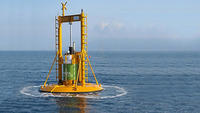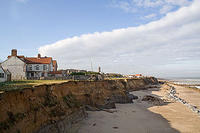-
Urchin-loving otters can help fight global warming

A thriving sea otter population that keeps sea urchins in check will in turn allow kelp forests to prosper; the spreading kelp can absorb as much as twelve times the amount of CO2 from the atmosphere than if it were subject to ravenous sea urchins
-
-
Raytheon opens STEM teacher award program
Raytheon has opened the 2012 application process for its Raytheon-Engineering is Elementary (EiE) Teacher Scholarship Program; during the 2012-13 school year, Raytheon will grant awards of $3,000 each for selected elementary school teachers nation-wide whose applications best demonstrate innovative methods of generating student enthusiasm about engineering concepts
-
-
New search-and-rescue tool: remotely controlled cockroaches

Researchers have developed a technique that uses an electronic interface to remotely control, or steer, cockroaches; remotely controlling cockroaches would allow first responders to create a mobile web of smart sensors that uses cockroaches to collect and transmit information, such as finding survivors in a building that has been destroyed by an earthquake
-
-
Protecting buildings from earthquakes by hiding them

Engineers have come up with an inventive and exciting idea for protecting buildings from earthquakes: hide them (the buildings, that is); the engineers say that placing specialized rubber under the building would diverts certain temblor shock waves, leaving the building virtually untouched by them
-
-
Scientists question earthquake prediction methods
From 2008 to 2011, three earthquakes have significantly damaged different parts of the world. Those quakes were significantly underestimated by scientists and seismologists
-
-
Crack-resistant components for bridges, roof structures, cars
Bridges, roof structures, cars, and more should become increasingly lighter, with the same stability, and thus save energy and materials; the new high-strength steel is superbly suited for the needed lightweight design because it can also withstand extremely heavy stresses; yet these materials also have a disadvantage: with increasing strength, their susceptibility to cold cracking rises when welded; cracks are difficult to predict — until now
-
-
Airbus unveils its 2050 vision for “Smarter Skies”
Global aircraft manufacturer Airbus the other day released the latest installment of the Future by Airbus, its vision for sustainable aviation in 2050 and beyond; the vision looks beyond aircraft design to how the aircraft is operated both on the ground and in the air in order to meet the expected growth in air travel in a sustainable way
-
-
Destroyed coastal habitats produce significant amounts of greenhouse gas

Destruction of coastal habitats may release as much as one billion tons of carbon into the atmosphere each year, ten times higher than previously reported; a new analysis provides the most comprehensive estimate of global carbon emissions from the loss of these coastal habitats to date: 0.15 to 1.2 billion tons; it suggests there is a high value associated with keeping these coastal-marine ecosystems intact as the release of their stored carbon costs roughly $6-$42 billion annually
-
-
Students create low-cost biosensor to detect contaminated water
Diarrheal disease is the second-leading cause of death in children under five years old — killing as many as 1.5 million children worldwide every year; these startling statistics from the World Health Organization (2009) point to the reason why a group of undergraduate students from Arizona State University is working to develop a low-cost biosensor — a simple device that would detect contaminated drinking water
-
-
DHS funds more tests of autonomous power buoy for ocean surveillance

Ocean Power Technologies (OPT) has entered into an agreement with DHS Science & Technology Directorate to perform a new round of in-ocean tests on the company’s Autonomous PowerBuoy to demonstrate its use for ocean surveillance
-
-
Powerful new explosive could replace today's state-of-the-art military explosive
Borrowing a technology used to improve the effectiveness of drugs, scientists are reporting discovery of a new explosive more powerful than the current state-of-the-art explosive used by the military
-
-
Innovative hydroelectric solution harvests power from water flowing through municipal pipes
An innovative solution has made it so dams do not have to be built in order to get hydroelectricity; hydroelectric power can now be harvested from water flowing through municipal pipes; the innovation is creating energy by using existing infrastructure, as well as solving a problem in that infrastructure
-
-
Law-enforcement agencies eager for Web-surveillance tools

Private technology firms are pitching software capable of analyzing large swaths of the Internet to local law enforcement looking for ways to stop the next mass shooting or domestic terrorist event before it happens; police departments hope the software will help them detect online information from terrorists, traffickers, pedophiles, and rioters
-
-
Coastline erosion due to rise in sea level greater than previously thought

The effects of coastline erosion as a result of rising sea-level rise can be measured by acceptable engineering tools, but such an erosion in the vicinity of inlets, such as river estuaries, has until now been underestimated – and more difficult to calculate; scientists have develop a new model to calculate this more complex erosion, making a valuable contribution to coastal management, planning, and infrastructure protection
-
-
Many of the U.S. 20 million manholes are in need of immediate rehabilitation or replacement

The EPA estimates that there are about twenty million manholes in the United States – or one manhole for every 400 feet of pavement on average; many of those manholes are in serious decay or in need of immediate rehabilitation or replacement
-
More headlines
The long view
New Technology is Keeping the Skies Safe
DHS S&T Baggage, Cargo, and People Screening (BCP) Program develops state-of-the-art screening solutions to help secure airspace, communities, and borders
Factories First: Winning the Drone War Before It Starts
Wars are won by factories before they are won on the battlefield,Martin C. Feldmann writes, noting that the United States lacks the manufacturing depth for the coming drone age. Rectifying this situation “will take far more than procurement tweaks,” Feldmann writes. “It demands a national-level, wartime-scale industrial mobilization.”
How Artificial General Intelligence Could Affect the Rise and Fall of Nations
Visions for potential AGI futures: A new report from RAND aims to stimulate thinking among policymakers about possible impacts of the development of artificial general intelligence (AGI) on geopolitics and the world order.
Smaller Nuclear Reactors Spark Renewed Interest in a Once-Shunned Energy Source
In the past two years, half the states have taken action to promote nuclear power, from creating nuclear task forces to integrating nuclear into long-term energy plans.
Keeping the Lights on with Nuclear Waste: Radiochemistry Transforms Nuclear Waste into Strategic Materials
How UNLV radiochemistry is pioneering the future of energy in the Southwest by salvaging strategic materials from nuclear dumps –and making it safe.
Model Predicts Long-Term Effects of Nuclear Waste on Underground Disposal Systems
The simulations matched results from an underground lab experiment in Switzerland, suggesting modeling could be used to validate the safety of nuclear disposal sites.
